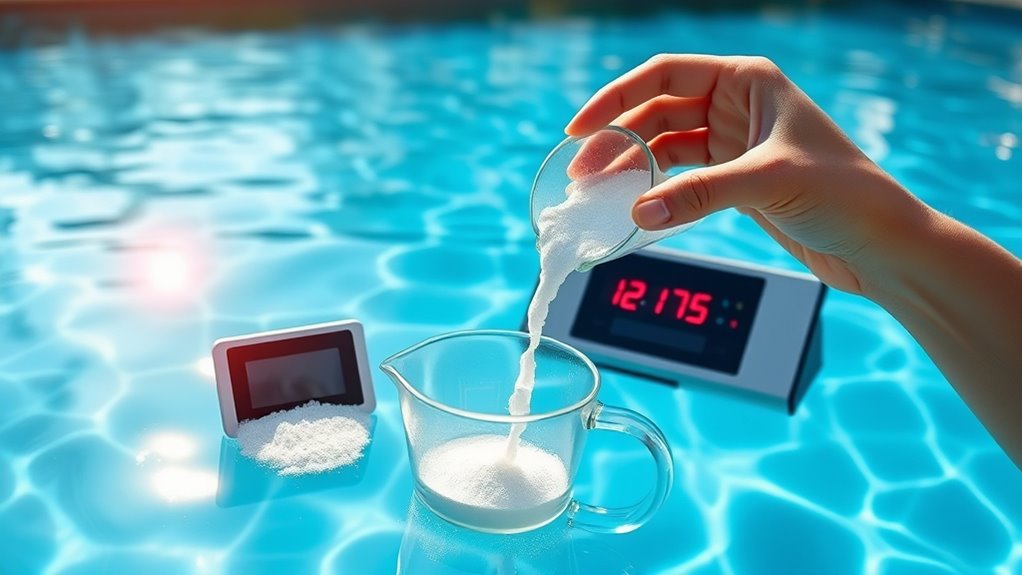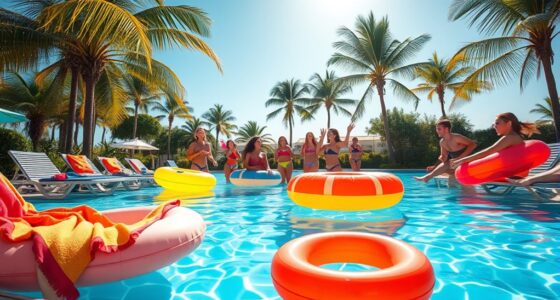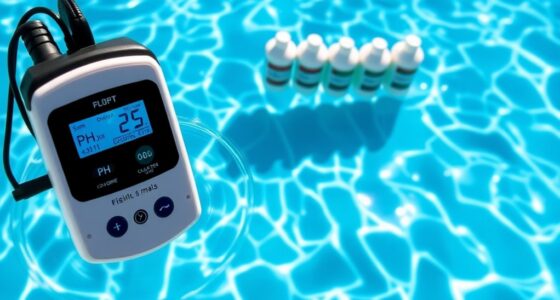To use cyanuric acid correctly, first test your pool’s current level and verify pH and alkalinity are balanced. Dissolve the stabilizer in warm water before adding it gradually through the skimmer near the pump. Always follow the manufacturer’s instructions based on your pool size and target cyanuric acid level, typically 30-50 ppm. Regularly check your levels afterward to prevent over-stabilization and keep your water safe and clear. If you want to master proper use, keep reading.
Key Takeaways
- Test current cyanuric acid levels before adding stabilizer to determine the correct amount needed.
- Dissolve cyanuric acid in warm water prior to pouring into the skimmer, avoiding direct addition of dry powder.
- Add cyanuric acid gradually in small increments, retesting after each to prevent over-stabilization.
- Maintain CYA levels between 30-50 ppm for outdoor pools, adjusting as needed based on test results.
- Handle cyanuric acid with gloves and goggles, storing it safely away from children, and follow manufacturer instructions carefully.
Understanding the Role of Cyanuric Acid in Pool Care
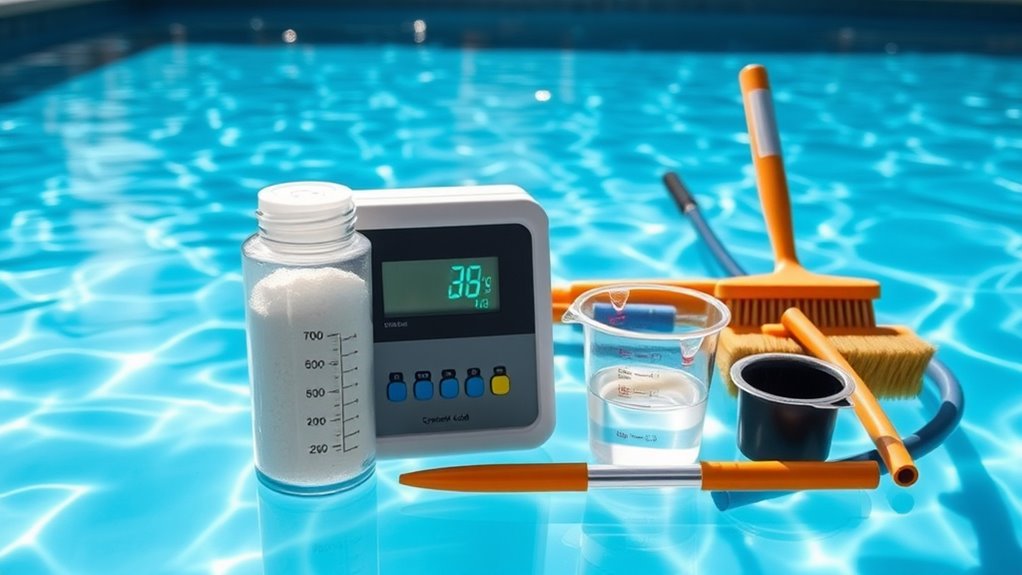
Understanding the role of cyanuric acid in pool care is essential for maintaining safe and effective sanitation. Cyanuric acid acts as a free chlorine buffer, helping protect your chlorine from rapid UV degradation. It’s introduced through stabilized chlorine products like trichlor tablets and dichlor granules, which form a ring with chlorine atoms, stabilizing them. In pool water, cyanuric acid exists mainly as the enol form and has a mildly acidic pH (~4.8), slightly lowering your pool’s pH when added. Its primary function is to form a weak bond with free chlorine, shielding it from sunlight’s UV rays. This slows chlorine breakdown, reducing “chlorine burn” and ensuring your pool stays sanitized longer, especially in outdoor environments with prolonged sun exposure. Cyanuric acid’s equilibrium structures constantly interconvert, which influences its stability and effectiveness in pool chemistry. Proper control of cyanuric acid levels is crucial to avoid overstabilization, which can impair chlorine’s ability to disinfect effectively.
Determining the Right Cyanuric Acid Levels for Your Pool
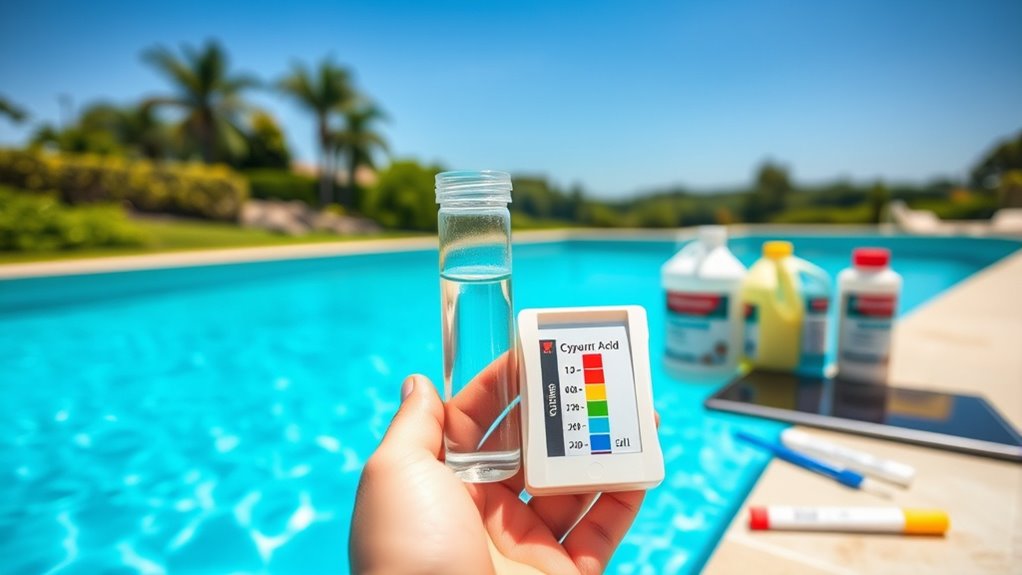
To keep your pool safe and clean, you need to maintain the right cyanuric acid levels. Too little CYA means chlorine breaks down quickly, while too much reduces sanitizer effectiveness. Regular testing and understanding the ideal range help prevent problems and keep your water balanced. Monitoring CYA levels regularly ensures you can make timely adjustments and avoid issues caused by improper stabilization. Proper Kia Tuning can also optimize your vehicle’s performance, which could be useful if you rely on your car for pool maintenance trips.
Ideal CYA Range
Maintaining the right cyanuric acid (CYA) level is essential for effective pool sanitation and chlorine stability. For most outdoor pools, aim for a CYA range of 30 to 50 ppm. Staying within this window protects your chlorine from UV breakdown while keeping it effective. If CYA drops below 30 ppm, sunlight rapidly depletes chlorine, risking algae growth. Exceeding 50 ppm can reduce chlorine’s ability to sanitize properly. Regular testing helps maintain balance, especially if you use dichlor or trichlor. Keep these points in mind:
- 30-50 ppm is ideal for outdoor pools.
- Below 30 ppm, chlorine degrades quickly.
- Above 50 ppm, chlorine effectiveness declines.
- Saltwater pools need 60-80 ppm CYA.
- Adjust CYA and chlorine levels regularly for optimal sanitation.
- Proper CYA management ensures consistent chlorine effectiveness and pool safety.
Risks of Excess CYA
Excess cyanuric acid can considerably impair your pool’s sanitation by binding with free chlorine and reducing its ability to disinfect effectively. When CYA levels are too high, chlorine becomes less available for killing bacteria and viruses, leading to chlorine lock. This means your water may look clear but still harbor harmful pathogens, increasing health risks. Higher cyanuric acid levels also cause cloudy water and make algae outbreaks more frequent, as chlorine’s algae-fighting properties weaken. Additionally, elevated CYA raises total dissolved solids, complicating water chemistry and requiring more frequent water replacements. The need for increased chemical use raises costs and maintenance efforts. Ultimately, too much cyanuric acid compromises water quality, safety, and clarity, making it essential to monitor and maintain proper levels. Monitoring and adjusting cyanuric acid levels regularly is crucial to prevent these issues and ensure a safe swimming environment. Proper water chemistry management helps maintain balanced levels and prevents the negative effects of excess CYA.
Testing and Maintenance
Regularly testing your pool’s cyanuric acid (CYA) levels is essential for keeping water chemistry balanced and ensuring effective sanitation. Consistent testing helps you maintain proper stabilizer levels, preventing chlorine from degrading quickly. Use reliable methods like turbidity test kits, color-change kits, test strips, lab analysis, or digital readers for accurate readings. Test weekly, especially before adding stabilizer, since CYA remains in water long-term. Keep CYA within 30–50 ppm for most pools, adjusting for outdoor exposure. Factors like heavy rain, splashouts, or refilling can lower CYA, requiring re-testing. Maintaining proper CYA levels is vital to prevent issues such as chlorine loss and algae growth. Regular testing also helps detect any unexpected fluctuations in CYA levels caused by water loss or dilution. Common signs of low CYA include rapid chlorine loss, cloudy water, and algae. Always follow manufacturer instructions when adding stabilizer and retest to confirm levels are within the ideal range.
Properly Adding Cyanuric Acid to Your Pool

To properly add cyanuric acid to your pool, start by testing the current CYA level to determine how much stabilizer is needed. Balance your pH and total alkalinity beforehand to guarantee ideal chemical effectiveness. Calculate the required amount of cyanuric acid based on your pool’s volume and target CYA level, and always read the manufacturer’s dosage instructions. For safer handling, wear protective eyewear, gloves, long sleeves, and pants. You can add cyanuric acid by dissolving the exact amount in a five-gallon bucket of warm water, then pouring it into the skimmer for even distribution. Run your pump for several hours to circulate the stabilizer thoroughly. Retest your CYA levels after full circulation and adjust if necessary, avoiding direct addition of dry cyanuric acid to prevent clogs or damage. Proper addition ensures effective stabilization and maintains a safe swimming environment. Additionally, understanding the filtration system of your pool can help improve the overall effectiveness of chemical treatments.
Monitoring and Maintaining Cyanuric Acid Levels

Monitoring cyanuric acid (CYA) levels consistently is essential to keeping your pool safe and effective. Regular testing helps prevent over- or under-stabilization, maintaining ideal chlorine performance. Use trusted test kits like Pentair or Taylor for accurate results, following instructions carefully. Be aware that CYA levels can fluctuate after heavy rain, splash-out, or partial water changes, so test after these events. Keep an eye on signs such as rapid chlorine depletion or cloudy water, which may indicate imbalances. To maintain proper levels, consider these practices:
Regularly test CYA levels to prevent imbalances and ensure safe, effective pool chlorine.
- Test weekly for consistent monitoring
- Use test strips or liquid reagent kits for precision
- Allow 24-48 hours after adding stabilizer before testing
- Adjust CYA gradually to avoid over-stabilization
- Avoid pouring undissolved CYA directly into the pool surface
- Understanding pool chemistry helps in making informed adjustments and maintaining water clarity.
Managing Over-Stabilization and Its Effects
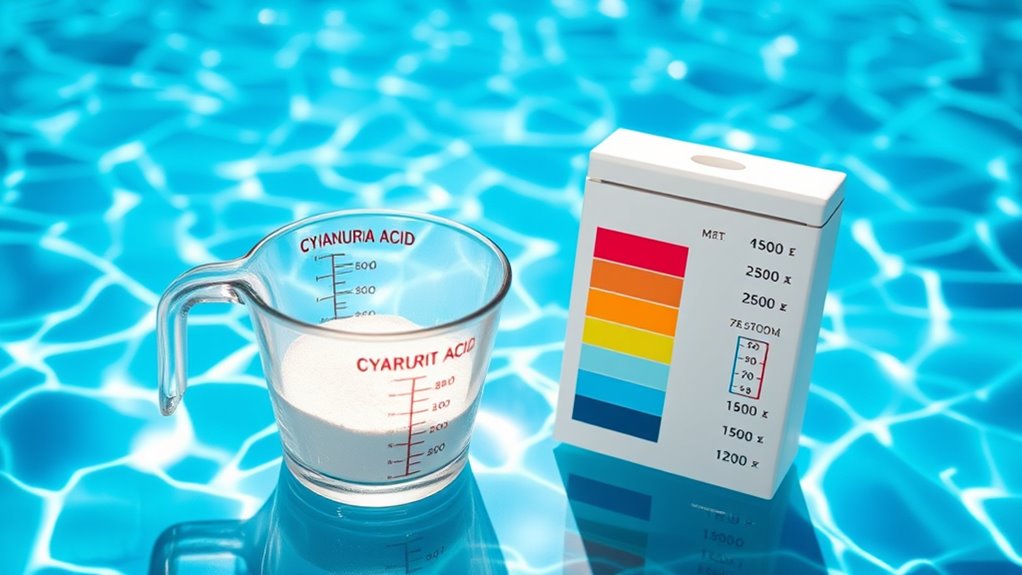
Over-stabilization of cyanuric acid (CYA) can substantially impair your pool’s disinfecting power, making it harder for chlorine to kill bacteria and algae effectively. Elevated CYA levels lock up chlorine molecules, reducing hypochlorous acid (HOCl) and slowing sanitation. As CYA surpasses 70 ppm, chlorine’s ability to disinfect decreases, risking longer bacterial persistence. You’ll notice cloudy water, algae growth, and increased odors from high CYA. To manage over-stabilization, consider partial draining or using a clarifier to improve water clarity. Here’s a quick overview:
| Action | Result |
|---|---|
| Lower CYA levels | Restores chlorine effectiveness |
| Regular testing | Prevents over-stabilization |
| Partial water replacement | Reduces excess cyanuric acid |
| Adjust chlorine dosage | Maintains proper sanitation |
| Monitor water chemistry | Keeps water balanced and safe |
| Understand stabilization to prevent future issues.
Best Practices for Safe and Effective Use
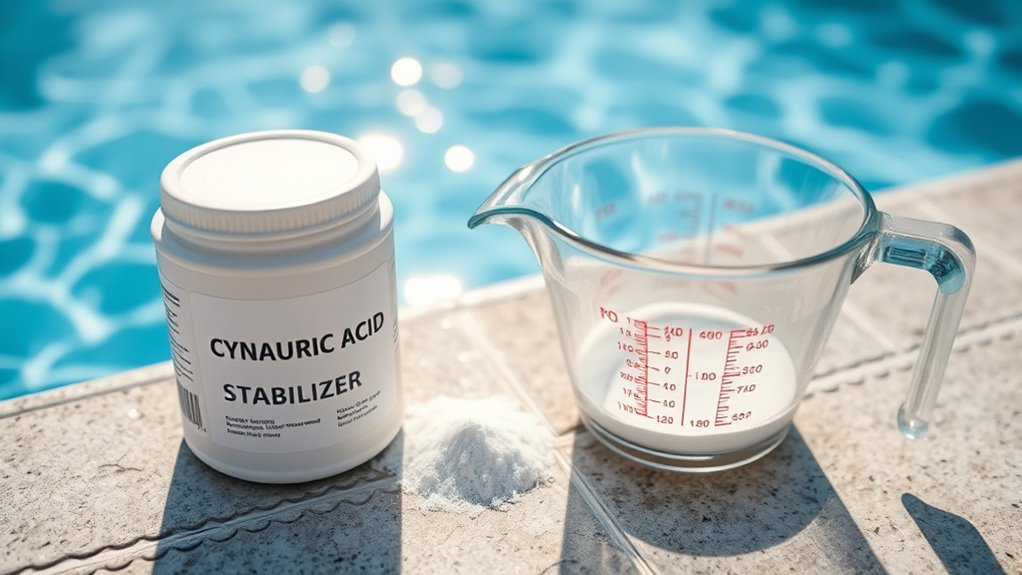
To use cyanuric acid safely and effectively, you need to follow proper dosage guidelines, handle the chemical carefully, and test your water regularly. Incorrect amounts or poor handling can diminish chlorine’s effectiveness and pose health risks. Staying vigilant with testing ensures your pool stays balanced and safe for swimmers. Regular monitoring is essential, as CYA levels can change over time due to water replacement or evaporation, affecting overall water chemistry. Additionally, understanding the importance of proper maintenance can help prevent issues related to improper cyanuric acid levels.
Proper Dosage Guidelines
Ensuring you add the correct amount of cyanuric acid (CYA) is essential for safe and effective pool stabilization. To do this, always calculate your needed dosage based on your pool’s volume and current CYA level. For example, 13 ounces of CYA raises levels by 10 ppm in a 10,000-gallon pool, while 2.5 kg raises 50 ppm in a 50,000-liter pool. Remember, exceeding 100 ppm can reduce chlorine effectiveness, so monitor levels regularly. Here are key guidelines to follow:
- Use a CYA calculator for precise dosing
- Add stabilizer gradually in increments
- Retest after each addition before further dosing
- Add slowly through the skimmer near the pump
- Avoid overdosing to prevent issues
- Accurate measurement of pool volume ensures proper dosing and prevents over- or under-stabilization. Properly understanding your pool size and volume is crucial for effective stabilization.
Following these steps ensures safe, effective stabilization.
Safe Handling Procedures
Handling cyanuric acid safely is vital to prevent accidents and guarantee the chemical works effectively. Always wear protective gear, such as gloves and goggles, when handling the powder. Store it in a cool, dry place away from children and pets. Avoid inhaling dust by handling it gently and in well-ventilated areas. Use a scoop or measuring device to prevent spills and overuse. Here’s a quick safety overview:
| Precaution | Action | Purpose |
|---|---|---|
| Wear protective gear | Gloves, goggles | Prevent skin and eye irritation |
| Store properly | Cool, dry, labeled container | Maintain chemical stability |
| Handle in ventilated area | Use outdoors or a well-ventilated space | Minimize inhalation risk |
| Use measuring tools | Scoop carefully, avoid spills | Ensure accurate, safe use |
A good understanding of chemical safety practices can greatly reduce the risk of accidents during handling.
Regular Testing Importance
Why is regular testing of cyanuric acid crucial for maintaining a safe and effective pool? Because it ensures your CYA levels stay within the ideal range, preventing issues like rapid chlorine loss or ineffective sanitation. Regular testing helps you catch gradual changes caused by rain, splashout, or water replacement before problems escalate. Testing before adding CYA prevents over-stabilization, while frequent checks during hot, sunny days reveal dilution or improper water management. If your in-home kits aren’t accurate, professional testing at pool stores is essential. Proper testing techniques, such as accurate sample collection, are vital for reliable results. Imagine:
- Weekly testing to track gradual shifts
- Testing after heavy rain or water replacement
- Using reliable test kits or professional services
- Collecting samples properly from 18 inches below the surface
- Monitoring CYA levels within 30-50 ppm for safety
Frequently Asked Questions
Can Cyanuric Acid Be Used With Saltwater Pools?
Yes, you can use cyanuric acid with saltwater pools. It helps stabilize your free chlorine against UV degradation, extending its sanitizing power. Keep CYA levels between 60-80 ppm for maximum protection, and always test regularly to prevent over-stabilization. Remember, maintaining the right CYA-to-chlorine ratio is essential for effective sanitation. Use CYA-compatible products designed for saltwater pools to guarantee water clarity and proper chemical balance.
How Long Does It Take for Cyanuric Acid to Dissolve Completely?
You’ll find that liquid cyanuric acid usually dissolves within 24 hours, giving you quick results. In contrast, granular cyanuric acid can take 5 to 7 days to fully dissolve, especially in cooler water. To speed up dissolution, keep the water warm, circulate the pool, and pre-dissolve the granules in warm water before adding them. Always wait at least a week before testing CYA levels after granular addition.
Is It Safe to Add Cyanuric Acid Directly Into the Pool?
Adding cyanuric acid directly into your pool isn’t safe because it can cause localized high concentrations, damaging surfaces or irritating your skin and eyes. Instead, you should dissolve it in a bucket of water first, then pour it slowly around the pool for even distribution. Always avoid adding CYA when swimmers are present, and wear protective gear to prevent inhalation or skin contact. Proper handling guarantees safety and effective stabilization.
How Often Should I Test Cyanuric Acid Levels?
Imagine your pool’s chemistry as a delicate dance, where timing keeps everything in harmony. You should check cyanuric acid levels about once a month, especially before and after the swimming season. This helps guarantee the stabilizer stays within safe limits. If the pool gets used heavily or experiences heavy rain, consider testing more frequently. Regular testing keeps your pool balanced, safe, and sparkling for everyone to enjoy.
Can Cyanuric Acid Cause Skin or Eye Irritation?
Yes, cyanuric acid can cause skin and eye irritation if you’re exposed to it directly. You might experience redness, itching, or even more severe irritation on your skin. In your eyes, it can lead to tearing, redness, blurred vision, or discomfort. To stay safe, always wear protective gloves and goggles when handling it and rinse thoroughly with water if you come into contact. Seek medical help if symptoms persist.
Conclusion
Think of cyanuric acid as the shield that protects your pool from the sun’s harsh rays. When used correctly, it keeps your water clear and safe, like a sturdy fortress. But too much can weaken its defense, just like an overgrown shield becomes heavy and unwieldy. By monitoring and maintaining proper levels, you’ll keep your pool’s health in check—your best weapon against cloudy, uninviting water. Stay vigilant, and enjoy your sparkling oasis.

